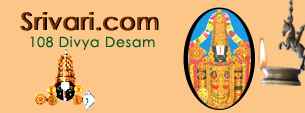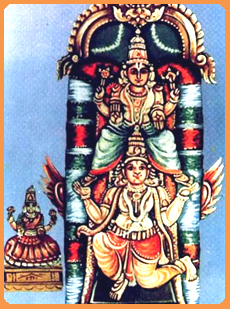 |
 |
Thiruvitthuvakkodu |
| Home |
|
| History - Thiruvitthuvakkodu |
|
Thaayaar - Vithuvakottuvalli, Padmabaani Naachiyaar. Theertham - Chakra Theertham. |
| Mangalasasanam: |
| Kulasekaralwar - 688-697.
Total of 10 Paasurams. |
| Special Information | |
| Dieties | Uyya Vandha Perumaal, Vithuvakkottu Valli |
| Vimanam | Thathuva Kanchana Vimanam |
| Theerthangal | Chakra Theertham |
| Mangalasasanam | Kulasekarazhwar |
| Pratyaksham | Ambareeshan |
| Direction and Posture | South-faced and Bhujanga Shyanam |
| Access to the temple | Near Pattambi Rly. Station(26 Kms. From Guruvayoor)
|
| Moolavar |
| The Moolavar of
this sthalam is Uyyavandha Perumal. He is found in Nindra Thirukkolam
facing his thirumugham along the south direction. He is also named
as "Abhayapirathan". The perumal is prathyaksham for Ambhareeshan.
|
| How to Get There. |
This sthalam is found in between Shoranoor to Kallikkottai, next to Pattambi. We can also reach this sthalam while travelling through Shoranoor to Guruvayoor and has to travel around 10 kms . While travelling in train, we have to get down in Pattambi railway station which is found on the Shoranoor - Kallikkottai lane and after travelling 2 kms, we can reach this sthalam. Staying facility in Pattambi is available. This sthalam is popularly called as " Anjumoorthy Koil ". |
 As
per sthalapurana, the Lord took the four forms as Ambarisha wished
to worship the Paradevata in Vyoohavatar roopa and obtain His blessings.
It is believed that Dharmaputra worshipped the Perumal at the centre,
Arjuna - the one on the west side, Bheema - the one on the left
and Nakula and Sahadeva worshipped the Lord on the right side. Ambarisha
attained Moksha here.
As
per sthalapurana, the Lord took the four forms as Ambarisha wished
to worship the Paradevata in Vyoohavatar roopa and obtain His blessings.
It is believed that Dharmaputra worshipped the Perumal at the centre,
Arjuna - the one on the west side, Bheema - the one on the left
and Nakula and Sahadeva worshipped the Lord on the right side. Ambarisha
attained Moksha here.